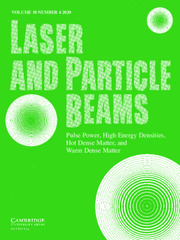Crossref Citations
This article has been cited by the following publications. This list is generated based on data provided by
Crossref.
Kwan, T.J.T.
Moir, M.C.
and
Snell, C.M.
1999.
Simulations, experiments, and analysis of beam target interaction.
Vol. 3,
Issue. ,
p.
1842.
Vermare, C.
Labrouche, J.
Le Taillandier de Gabory, P.
Villate, D.
and
Donohue, J.T.
1999.
Strong self-focusing of a 7.2 MeV electron beam striking an aluminized mylar target.
IEEE Transactions on Plasma Science,
Vol. 27,
Issue. 6,
p.
1566.
Kwan, T.J.T.
and
Snell, C.M.
1999.
Plasma suppression and spot size stabilization in single and multiple pulse flash X-ray radiography.
p.
181.
Vermare, C.
Donohue, J.T.
Labrouche, J.
Le Taillandier de Gabory, P.
and
Villate, D.
1999.
Observation of strong self-focusing of an intense relativistic electron beam impinging on a SiO/sub 2/ target.
IEEE Transactions on Plasma Science,
Vol. 27,
Issue. 5,
p.
1501.
Yu-Jiuan Chen
Bergstrom, P.M.
Caporaso, G.J.
Ho, D.-M.
McCarrick, J.F.
Pincosy, P.A.
and
Rambo, P.W.
1999.
DARHT2 X-ray converter target system comparison.
Vol. 3,
Issue. ,
p.
1827.
Maenchen, J.
Cordova, S.
Gustwiller, J.
Johnson, D.L.
Menge, P.
Molina, I.
Olson, C.
Rosenthal, S.
Rovang, D.
Oliver, O.
Welch, D.
Bailey, V.
Smith, I.
Droemer, D.
Hunt, E.
MacLeod, G.
and
Woo, L.
1999.
Inductive voltage adder driven X-ray sources for hydrodynamic radiography.
Vol. 1,
Issue. ,
p.
279.
Kwan, Thomas J. T.
and
Snell, Charles M.
2000.
Plasma and ion barrier for electron beam spot stability.
Review of Scientific Instruments,
Vol. 71,
Issue. 3,
p.
1363.
Haworth, M. D.
Englert, T. J.
Hendricks, K. J.
Lemke, R. W.
Luginsland, J. W.
Shiffler, D. S.
and
Spencer, T. A.
2000.
Comprehensive diagnostic suite for a magnetically insulated transmission line oscillator.
Review of Scientific Instruments,
Vol. 71,
Issue. 3,
p.
1539.
Kwan, Thomas J. T.
Snell, Charles M.
and
Christenson, Peggy J.
2000.
Electron beam–target interaction and spot size stabilization in flash x-ray radiography.
Physics of Plasmas,
Vol. 7,
Issue. 5,
p.
2215.
Kwan, T.J.T.
2000.
On the delay time for the onset of radiographic spot size growth.
IEEE Transactions on Plasma Science,
Vol. 28,
Issue. 1,
p.
268.
Lemke, R.W.
Luginsland, J.W.
and
Haworth, M.D.
2000.
Evidence of a new pulse-shortening mechanism in a load-limited MILO.
IEEE Transactions on Plasma Science,
Vol. 28,
Issue. 3,
p.
511.
Davis, H.A.
Vermare, C.
Hughes, T.P.
Moir, D.C.
Olson, R.T.
and
Wood, W.M.
2001.
Intense electron beam disruption due to ion release from surfaces.
Vol. 5,
Issue. ,
p.
3290.
Vermare, C.
Davis, H.A.
Hughes, T.P.
Moir, D.C.
Olson, R.T.
and
Wood, W.M.
2001.
Intense electron beam disruption due to ion release from surfaces.
p.
1685.
Rose, D. V.
Welch, D. R.
Oliver, B. V.
Clark, R. E.
Johnson, D. L.
Maenchen, J. E.
Menge, P. R.
Olson, C. L.
and
Rovang, D. C.
2002.
Coupled particle-in-cell and Monte Carlo transport modeling of intense radiographic sources.
Journal of Applied Physics,
Vol. 91,
Issue. 5,
p.
3328.
Rovang, D.
Cordova, S.
Hahn, K.
Maenchen, J.
Molina, I.
Portillo, S.
Sceiford, M.
Droemer, D.
Van De Valde, D.
Oliver, B.
Rose, D.
Welch, D.
and
Johnson, D.L.
2003.
Recent progress in the development of immersed diodes.
Vol. 1,
Issue. ,
p.
487.
Ekdahl, C.
Abeyta, E.O.
Caudill, L.
Chan, K.C.D.
Dalmas, D.
Eversole, S.
Gallegos, R.
Harrison, J.
Holzscheiter, M.
Johnson, J.
Jacquez, E.
McCuistian, B.T.
Montoya, N.
Nielsen, K.
Oro, D.
Rodriguez, L.
Rodriguez, P.
Sanchez, M.
Schauer, M.
Simmons, D.
Smith, H.V.
Studebaker, J.
Sullivan, G.
Swinney, C.
Temple, R.
Chen, Y.J.
Houck, T.
Henestroza, E.
Eylon, S.
Fawley, W.
Yu, S.S.
Bender, H.
Broste, W.
Carlson, C.
Durtschi, G.
Frayer, D.
Johnson, D.
Jones, K.
Meidinger, A.
Moy, K.
Sturgess, R.
Tom, C.Y.
Hughes, T.
and
Mostrom, C.
2003.
First beam at DARHT-II.
p.
558.
McCarrick, J.
Caporaso, G.
Chambers, F.
Chen, Y.-J.
Falabella, S.
Goldin, F.
Guethlein, G.
Ho, D.
Richardson, R.
and
Weir, J.
2003.
Electron beam/converter target interactions in radiographic accelerators.
p.
563.
Vermare, C.
Davis, H. A.
Moir, D. C.
and
Hughes, T. P.
2003.
Ion emission from solid surfaces induced by intense electron beam impact.
Physics of Plasmas,
Vol. 10,
Issue. 1,
p.
277.
Rose, D. V.
Genoni, T. C.
and
Welch, D. R.
2004.
Ion-hose instability growth and saturation for counterstreaming electron and ion beams in an applied magnetic field.
Physics of Plasmas,
Vol. 11,
Issue. 11,
p.
4990.
Maenchen, J.
Cooperstein, G.
O'Malley, J.
and
Smith, I.
2004.
Advances in pulsed power-driven radiography systems.
Proceedings of the IEEE,
Vol. 92,
Issue. 7,
p.
1021.

